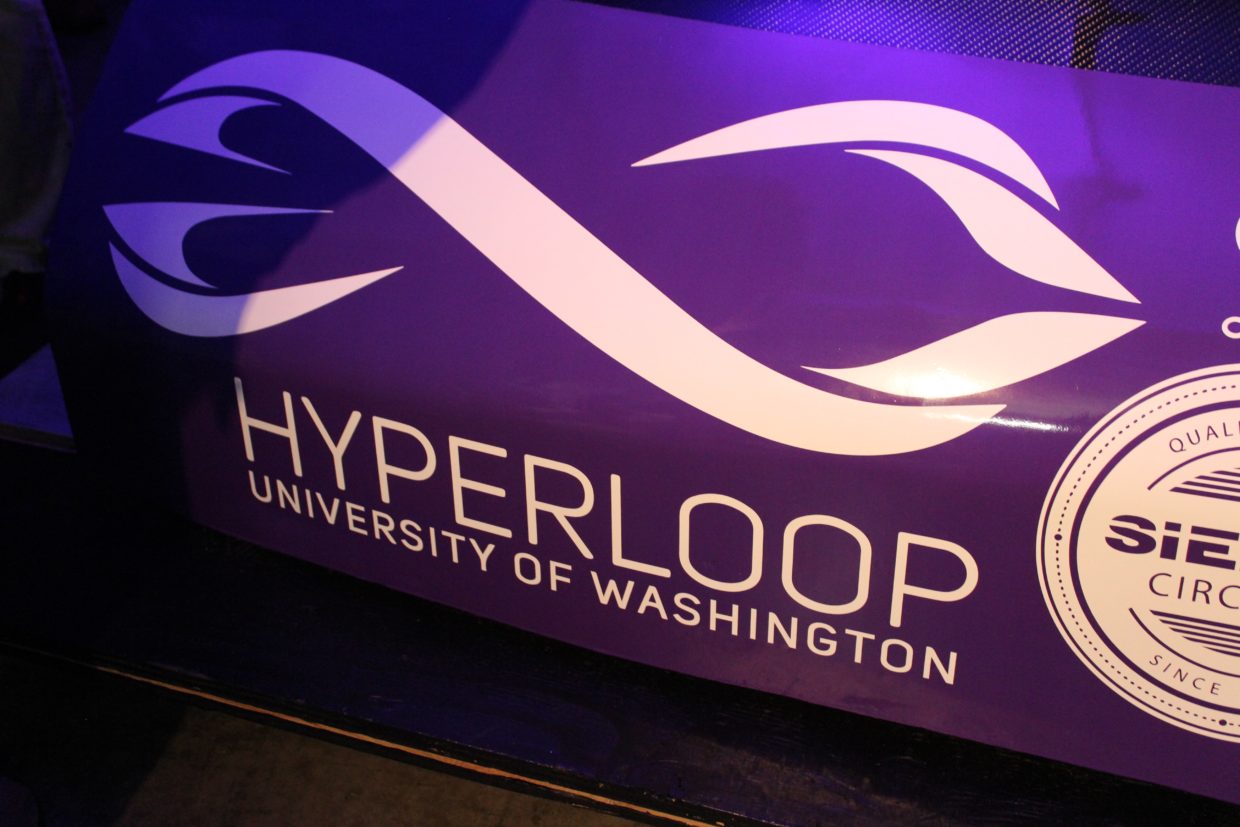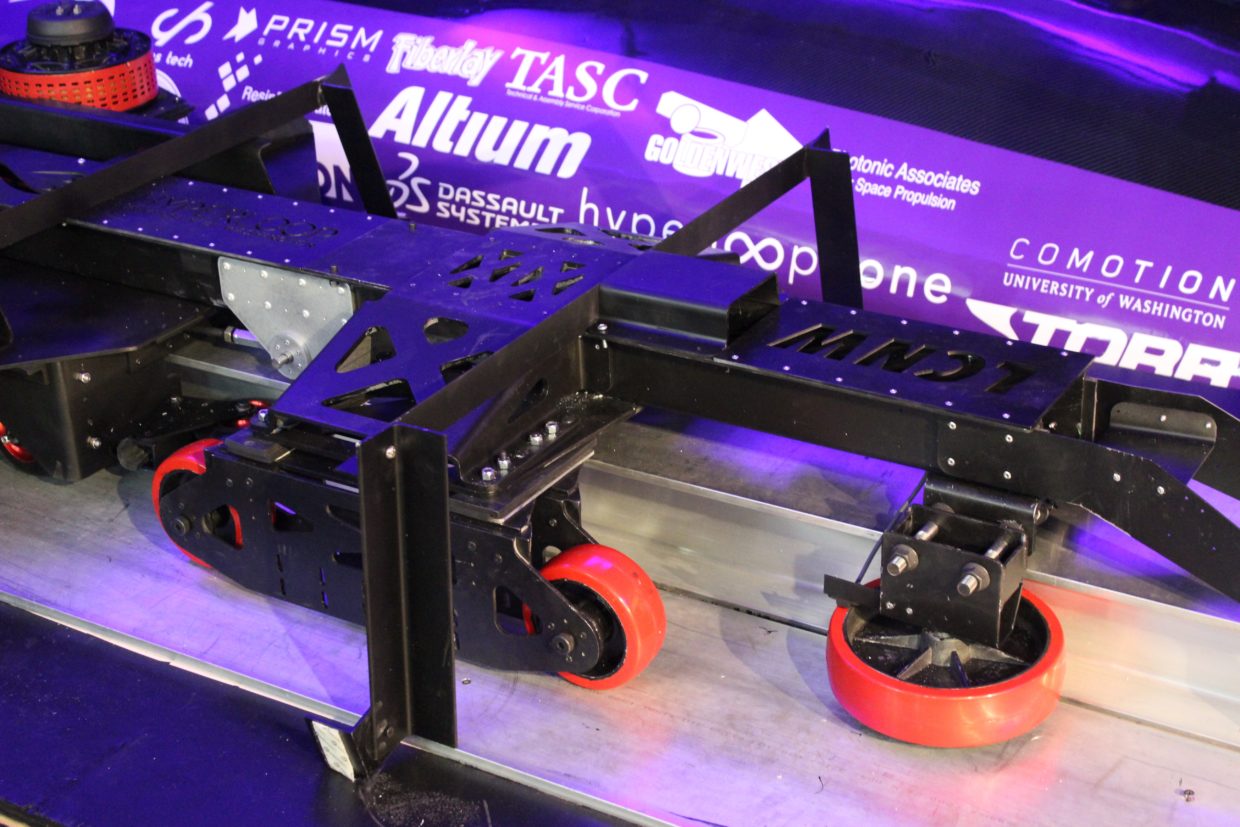
The University of Washington’s Hyperloop team showed off its sleek pod racer and let fans take a peek under the carbon composite hood, one week before a national competition in California.
For the team’s roughly 35 students, Thursday night’s unveiling at the GloCal Composites Lab in Seattle’s Eastlake neighborhood was an opportunity to celebrate the purple-tinted fruits of their labor.
“Everyone is committed to being a part of something bigger than themselves, grander than the team itself, and ultimately as a part of history as we think about the next mode of transportation,” UW engineering student David Coven, one of the team’s leaders, told the gathering of students and faculty, guests and journalists.
In its grandest form, the Hyperloop concept calls for shooting passenger pods through tubes at near-supersonic speeds. SpaceX founder Elon Musk came up with the idea in 2013 as a means of traveling between San Francisco and Los Angeles in about a half-hour.
Musk is leaving the commercialization of the concept to others, but in the meantime, SpaceX is sponsoring a college competition for scaled-down models of the pods. Coven said he and other students at UW jumped at the opportunity.
“We couldn’t help ourselves,” he said.
In the beginning, 1,200 teams applied. The field was trimmed down to 150, and then to 30. A week from now, UW’s team and the other finalists will send their three-quarter-scale pods through a 1-mile-long tube track that’s been constructed next to SpaceX’s headquarters in Hawthorne, Calif.
The winner will be determined on the basis of speed as well as design elegance and safety. These test pods aren’t expected to go supersonic, but they could hit 300 mph or more.
Getting this far hasn’t been easy: The students worked long hours developing and testing the motors, frames and magnets that make up the guts of the racer. The first time they tried to build the carbon composite shell enclosing the undercarriage, the resin didn’t bond evenly and the shell had to be tossed out. But even that taught the team a valuable lesson.
“For the engineers out there, feel free to fail,” Coven joked.
- Check out views of the UW Hyperloop team’s pod racer. (GeekWire Photos / Taylor Soper)
- The UW Hyperloop pod is brought out under wraps. (GeekWire Photo / Alan Boyle)
- The UW Hyperloop team pulls the wraps off the pod racer. (GeekWire Photo / Alan Boyle)
- The UW Hyperloop team surrounds the unveiled pod. (GeekWire Photo / Taylor Soper)
- The pod is designed to ride on a rail. (GeekWire Photo / Taylor Soper)
- The pod’s paint job pays tribute to Husky purple (and the team’s sponsors).
- A peekaboo look at the pod’s open back end reveals the undercarriage.
- The UW team removes the shell to reveal the undercarriage.
- The pod is powered by an array of magnets and motors.
- The “Remove Before Flight” label is a nod to aerospace.
- The wheels on the undercarriage get the pod up to speed.
- Teammates and guests check out the pod.
- Artwork shows a Hyperloop pod concept. (UW Graphic)
Coven and the other team members were guided by James Seferis, a former UW professor who went on to found GloCal Network Corp. The team also drew support from 20 sponsors and a crowdfunding campaign.
Seferis told the students that their experience working as a team was as valuable as the experience they gained in engineering. “You bonded more than you bond in a fraternity,” he told them.
Although the current Hyperloop competition reaches its climax at the Jan. 27-29 finals, SpaceX is already planning a follow-up contest this summer in which the fastest pod wins.
“We look to be a part of that competition, and one of the leading teams,” Coven said.
Seferis has even grander plans in mind: He’d like to see the UW team take on additional prototyping projects that range from electromagnetically controlled muscle systems to tube-launched drones.
“You can find all sorts of interesting stuff to do,” Seferis said. And as far as he’s concerned, the Hyperloop is not the limit.
















